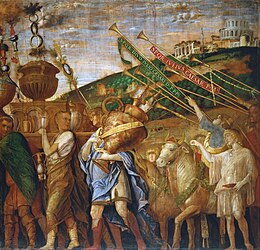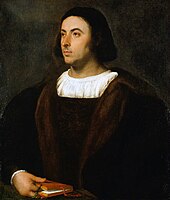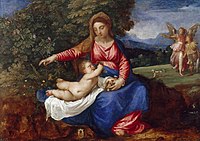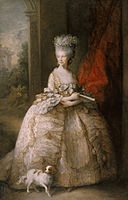
Buckingham Palace is a royal residence in London, and the administrative headquarters of the monarch of the United Kingdom. Located in the City of Westminster, the palace is often at the centre of state occasions and royal hospitality. It has been a focal point for the British people at times of national rejoicing and mourning.

Giacomo Francesco Zuccarelli was an Italian artist of the late Baroque or Rococo period. He is considered to be the most important landscape painter to have emerged from his adopted city of Venice during the mid-eighteenth century, and his Arcadian views became popular throughout Europe and especially in England where he resided for two extended periods. His patronage extended to the nobility, and he often collaborated with other artists such as Antonio Visentini and Bernardo Bellotto. In 1768, Zuccarelli became a founding member of the Royal Academy of Arts, and upon his final return to Italy, he was elected president of the Venetian Academy. In addition to his rural landscapes which frequently incorporated religious and classical themes, Zuccarelli created devotional pieces and on occasion did portraiture. Besides paintings, his varied output included etchings, drawings, and designs for tapestries as well as a set of Old Testament playing cards.

The Victoria and Albert Museum in London is the world's largest museum of applied arts, decorative arts and design, housing a permanent collection of over 2.27 million objects. It was founded in 1852 and named after Queen Victoria and Prince Albert.

Jean-Henri Riesener was a famous German ébéniste (cabinetmaker), working in Paris, whose work exemplified the early neoclassical "Louis XVI style".

The Wallace Collection is a museum in London occupying Hertford House in Manchester Square, the former townhouse of the Seymour family, Marquesses of Hertford. It is named after Sir Richard Wallace, who built the extensive collection, along with the Marquesses of Hertford, in the 18th and 19th centuries. The collection features fine and decorative arts from the 15th to the 19th centuries with important holdings of French 18th-century paintings, furniture, arms and armour, porcelain and Old Master paintings arranged into 25 galleries. It is open to the public and entry is free.

Anglesey Abbey is a National Trust property in the village of Lode, 5+1⁄2 miles (8.9 km) northeast of Cambridge, England. The property includes a country house, built on the remains of a priory, 98 acres of gardens and landscaped grounds, and a working mill.
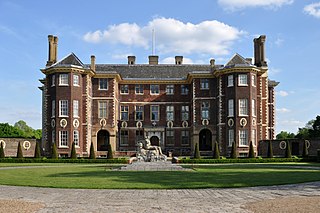
Ham House is a 17th-century house set in formal gardens on the bank of the River Thames in Ham, south of Richmond in the London Borough of Richmond upon Thames. The original house was completed in 1610 by Thomas Vavasour, an Elizabethan courtier and Knight Marshal to James I. It was then leased, and later bought, by William Murray, a close friend and supporter of Charles I. The English Civil War saw the house and much of the estate sequestrated, but Murray's wife Katherine regained them on payment of a fine. During the Protectorate his daughter Elizabeth, Countess of Dysart on her father's death in 1655, successfully navigated the prevailing anti-royalist sentiment and retained control of the estate.

Pietra dura or pietre dure, called parchin kari or parchinkari in the Indian Subcontinent, is a term for the inlay technique of using cut and fitted, highly polished colored stones to create images. It is considered a decorative art. The stonework, after the work is assembled loosely, is glued stone-by-stone to a substrate after having previously been "sliced and cut in different shape sections; and then assembled together so precisely that the contact between each section was practically invisible". Stability was achieved by grooving the undersides of the stones so that they interlocked, rather like a jigsaw puzzle, with everything held tautly in place by an encircling 'frame'. Many different colored stones, particularly marbles, were used, along with semiprecious, and even precious stones. It first appeared in Rome in the 16th century, reaching its full maturity in Florence. Pietra dura items are generally crafted on green, white or black marble base stones. Typically, the resulting panel is completely flat, but some examples where the image is in low relief were made, taking the work more into the area of hardstone carving.

The King's Gallery, previously known as the Queen's Gallery, is a public art gallery at Buckingham Palace, the official residence of the British monarch, in London. First opened to the public in the reign of Elizabeth II in 1962, it exhibits works of art from the Royal Collection on a rotating basis. Enlarged in the early 21st century, the gallery has its own separate public access entrance built in a 'new' classical style and typically displays about 450 works, mainly paintings and drawings.

Charles Cressent was a French furniture-maker, sculptor and fondeur-ciseleur of the régence style. As the second son of François Cressent, sculpteur du roi, and grandson of Charles Cressent, a furniture-maker of Amiens, who also became a sculptor, he inherited tastes, skills and aptitudes which contributed to his success as an artist. Even more important, perhaps, was the fact that he was a pupil of André-Charles Boulle. Cressent's distinction is closely connected with the regency, but his earlier work had affinities with the school of Boulle, while his later pieces were full of originality.
On 20 November 1992, a fire broke out in Windsor Castle, the largest inhabited castle in the world and one of the official residences of the British Monarch. The castle suffered extensive damage and was fully repaired within the next five years at a cost of £36.5 million, in a project led by the conservation architects Donald Insall Associates. It led to Queen Elizabeth II paying tax on her income, and to Buckingham Palace, the former monarch's other official residence, being opened to the public to help pay for the restoration work. This event was part of what Queen Elizabeth II called her annus horribilis.
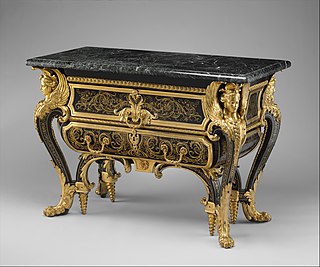
André-Charles Boulle, le joailler du meuble, became the most famous French cabinetmaker and the preeminent artist in the field of marquetry, also known as "inlay". Boulle was "the most remarkable of all French cabinetmakers". Jean-Baptiste Colbert recommended him to Louis XIV of France, the "Sun King", as "the most skilled craftsman in his profession". Over the centuries since his death, his name and that of his family has become associated with the art he perfected, the inlay of tortoiseshell, brass and pewter into ebony. It has become known as Boulle work, and the École Boulle, a college of fine arts and crafts and applied arts in Paris, continues today to bear testimony to his enduring art, the art of inlay.

Martin Carlin was a Parisian ébéniste (cabinet-maker), born at Freiburg, who was received as Master Ébéniste at Paris on 30 July 1766. Renowned for his "graceful furniture mounted with Sèvres porcelain", Carlin fed into the luxury market of eighteenth-century decorative arts, where porcelain-fitted furniture was considered among "the most exquisite furnishings" within the transitional and neoclassical styles. Carlin's furniture was popular amongst the main great dealers, including Poirier, Daguerre, and Darnault, who sold his furniture to Marie Antoinette and many amongst the social elite class. He died on 6 March 1785.
Augustin Blondel de Gagny was a French connoisseur of the arts and a collector whose series of Paris auction sales, which took place soon after his death were high-water marks of the history of collecting in 18th-century France. Paintings and sculptures that passed through Blondel de Gagny's collection are dispersed in many of the world's great museums. The prints from his collection are less easily traced.

Charles I in Three Positions, also known as the Triple Portrait of Charles I, is an oil painting of Charles I of England painted 1635–1636 by the Flemish artist Sir Anthony van Dyck, showing the king from three viewpoints: left full profile, face on, and right three-quarter profile. It is currently part of the Royal Collection.
Lignereux is a French company, founded in 1787, which produces objets d'art. Established in Paris and London, Lignereux plays a major role in decorative arts. Lignereux makes objects which are intended for art collectors. In 2015 Lignereux began to produce new objects, decorated by contemporary artists and craftspeople.

The furniture of Louis XIV was massive and lavishly covered with sculpture and ornament of gilded bronze in the earlier part of the personal rule of King Louis XIV of France (1660–1690). After about 1690, thanks in large part to the furniture designer André Charles Boulle, a more original and delicate style appeared, sometimes known as Boulle work. It was based on the use of marquetry, the inlay of pieces of ebony and other rare woods, a technique first used in Florence in the 15th century, which was refined and developed by Boulle and others working for the King. Furniture was inlaid with thin plaques of ebony, copper, mother of pearl, and exotic woods of different colors in elaborate designs.

The Casa-Museu Medeiros e Almeida is one of the most important Portuguese private decorative arts collections, gathered by the businessman, collector, and benefactor António Medeiros e Almeida (1895–1986).

The Yellow Drawing Room is a room in Buckingham Palace. It is noted for its Chinoiserie decorative scheme and has been the setting for many portraits of members of the British royal family.

Luc-Vincent Thiéry (1734–1822) was a French lawyer and author, best known for his publications about Paris.



